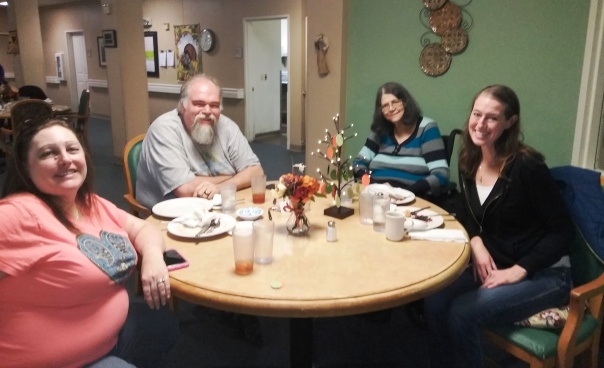
The Gratitude Tree is a great exercise to figure out what makes you thankful by placing leaves on the metal branches.
Each year, my family and I write on cutout leaves what we’re thankful for and put them on the Gratitude Tree.
The tradition, in its third year this year, is something we do at my mother’s assisted living facility during the Thanksgiving noon meal of the traditional fare of turkey, the sides and pumpkin pie. The volunteer director of activities greeted the 75 people in the room Nov. 22 and asked them to write down one thing but to choose something that isn’t obvious like family or friends. She gave us a half-hour while we started eating and then walked around the room holding up the Gratitude Tree, a metal centerpiece with wire branches, which we filled with the leaves.
I had to think, because my obvious ones are family, friends, writing and having a job. I also love coffee and had put that last year, along with my dog, Zoey, my apartment and my business, because we weren’t limited to just one leaf, and I took four of the leaves left in a small pile on our table.
Starting the Day with Gratitude
We started eating, and I couldn’t think of what to put that isn’t obvious. I thought about how I start my day—with running and drinking coffee—and how both give me energy as my happy kick starters.
I run to boost my metabolism and get rid of my pain—I have fibromyalgia—and I drink coffee for the caffeine rush and mental stimulation. In other words, I’m thankful I don’t have to take medication and can use exercise as treatment, and I have coffee to look forward to once I’m out the door and started with my day. Both serve as a form of motivation to get going and part of my going is writing.
My mom wrote, “The first sip of coffee in the morning,” saying she likes the taste and how it gets her going, too. My brother, Brian, put Mountain Dew, because that’s how he gets his energy boost. For my brother’s wife, it’s “Music and Movies.”

My family poses in front of the Gratitude Tree. From left are my sister-in-law, Kim, my brother, Brian, my mother, Mary, and me, Shelley Widhalm of Shell’s Ink Services.
I saw from the activity that I have a deeper level of thankfulness—I, too, work on daily gratitude and repeating my list of things that give me a thankful pause.
Reflecting on what makes us thankful is incredibly important for positive mental health. Writing out that gratitude is helpful and a great reminder when negative thoughts interrupt and dampen the holidays or the start of a day. I like to run toward positivity full of energy, filling my writing cup.
If you like to write, what do you love about writing?
Thankful for Writing
Here are a few reasons I’m thankful for writing. Writing is a way to:
- Have a hobby or job that results in a physical product.
- Be creative, even for a few minutes or a few hours.
- Express yourself and figure out what you really think or feel about something.
- Make connections with memory or experiences that you might not otherwise make by thinking or talking.
- Play around with words and language—it’s similar to a puzzle where you have to figure out what and how to write.
- Improve your use of language and ability to effectively get your message across.
- Tell stories and disappear into another world.
It’s interesting to see what you create out of the blank page, though intentional about your form, such as something short, like a blog or poem, to something spanning the length of a book. Writing is a process of discovery that also gives you a sense of accomplishment, just like running for a certain mile or time count. It’s a pleasure just like that first sip of coffee.
What parts of writing make you grateful that you love to write?
